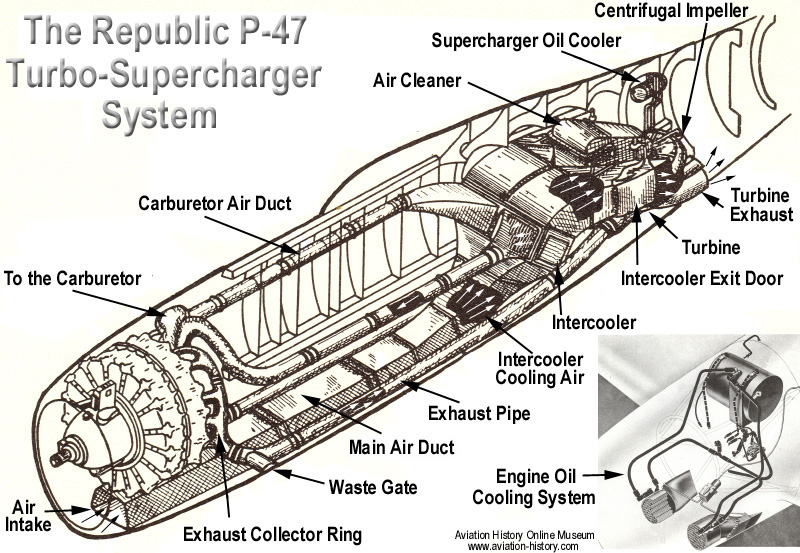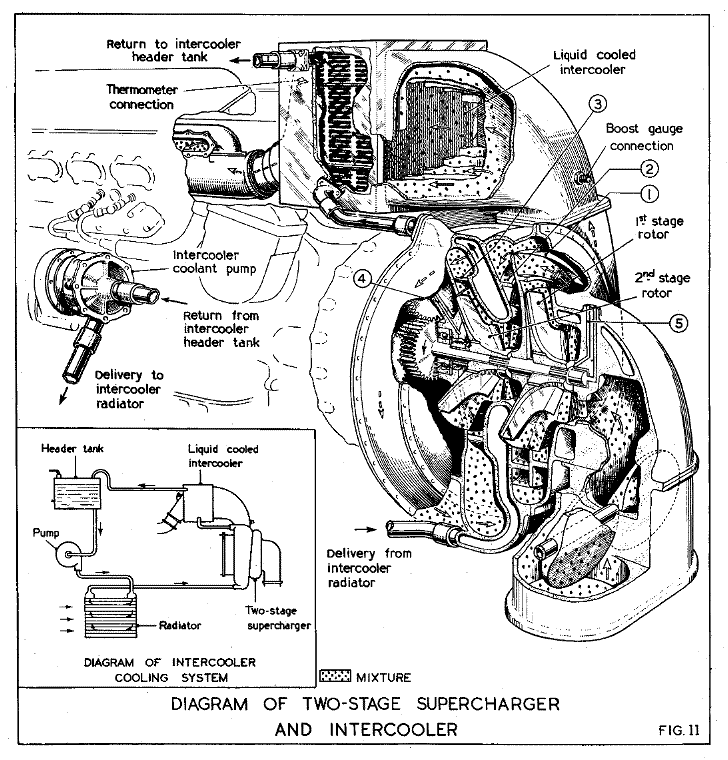
 |
|
|||||||
| IL-2 Sturmovik The famous combat flight simulator. |
 |
|
|
Thread Tools | Display Modes |
|
#11
|
||||
|
||||
|
Quote:
Turbine is just that - a turbine. Turbocharger is driven by the kinetic energy of exhaust gases. It does not use the same exhaust gases to feed the engine. It sucks in the same air the normal, mechanically driven supercharger would. The only scenario where you would use (recirculated) exhaust gases is when you want to lower emissions set by certain standard (e.g. EGR valve). And this is way too modern technology for WW2. Quote:
Exhaust valves / TC + fresh air => IC (for TC) => SC > engine intake valves (or manifold if you want).
__________________
LEVEL BOMBING MANUAL v2.0 | Dedicated Bomber Squadron 'MUSTANG' - compilation of online air victories |
|
#12
|
||||
|
||||
|
Interesting, looks simililar to a p47 in concept, i would guess that cooling down the exhaust just allowed lower temps in the turbo parts, maybe better for extended use? What was the range of the 190c, was it a short range interceptor?
|
|
#13
|
||||
|
||||
|
No, the supercharger on the DB60x series is fitted directly to the intake manifold.
The path is Air-Turbo-Intercooler-Supercharger-Intake-Exhaust-Turbo-Air The amount of energy in the exhaust gasses is so tremendous that even flying with -50 C hardly cools it, and the pressure remains high until the gas has expanded behind the turbo. Edit: Thor was sooner |
|
#14
|
|||
|
|||
|
Maybe because you misunderstood the drawing...
Red: Exhaust light blue: fresh compressed hot air blue: cooled down compressed air I did not draw the point where the exhaust gases leve the system, nor the the actual intake. Back to the 190: Quote:
Last edited by swiss; 12-22-2010 at 08:59 PM. |
|
#15
|
||||
|
||||
|
Quote:
What you drew looks alright by me. Azimech also understood it like I did.
__________________
LEVEL BOMBING MANUAL v2.0 | Dedicated Bomber Squadron 'MUSTANG' - compilation of online air victories |
|
#16
|
|||
|
|||
|
Great, we finally agree.
But I still dont get Turbo->SC. It says they used an additional turbo, but nowhere a modified charger, which they probably had to, since it had to deal with altered pressure. Also, I thought SC work with lower pressure compared to turbos. Plus, the SC is fed with (still)hot air and heats its up again. I have some doubts concerning efficiency, what is the SC's purpose? Reduce IC lag? I guess I'll have to do some research. Quote:
That is according to the infos I just found. I'd be more than happy to hear about a combo system.  
Last edited by swiss; 12-20-2010 at 08:51 PM. |
|
#17
|
|||
|
|||
|
Quote:
P-47 Engine, supercharger in blue colour, carburetor is the black thing on top of it:  Another view, showing the duct leading to carb, blue object is the supercharger:  Rolls Royce Merlin had almost the same setup (I think most WW2 engines did), except it had an liquid cooled intercooler as the last thing before the intake. Also of note here (two stage version) is that the air is cooled between the stages too!  Hope this helps, I get sometimes confused with this technology too.
__________________
~~~~~~~~~~~~~~~~~~~ Redguys Air Racing Team Member A4 www.simairracing.com "The fastest pilots of the online world..." Last edited by koivis; 12-20-2010 at 09:38 PM. |
|
#18
|
||||
|
||||
|
Yeah.
Quote:
I am guessing it has something to do along the lines what Azimech wrote: Quote:
On the second thought... Quote:
Unless... Doh! But of course. I am 90% sure this is a Pressure Carburetor since allied engines didn't have fuel injection. So you could say this was a form of fuel injection - to prevent negative G cutouts. Or at least has something to do with how Pressure Carburetor functions. Question here is - is Fw-190C using proper mechanical fuel injection or a Pressure Carburetor as well? Quote:
A very interesting thread if I may say so!
__________________
LEVEL BOMBING MANUAL v2.0 | Dedicated Bomber Squadron 'MUSTANG' - compilation of online air victories Last edited by T}{OR; 12-20-2010 at 10:02 PM. |
|
#19
|
||||
|
||||
|
After skimming through this document:
http://faculty.sdmiramar.edu/wnorth/249/249six.pdf I am not so sure what this last supercharger is for. If someone can provide more accurate drawings maybe it will be more clear. I can't make out exactly how it works from the pictures posted. And the added bonus is the fact it is already and hour past midnight here. So I will continue this discussion tomorrow. EDIT: Something like this: 
__________________
LEVEL BOMBING MANUAL v2.0 | Dedicated Bomber Squadron 'MUSTANG' - compilation of online air victories Last edited by T}{OR; 12-20-2010 at 10:38 PM. |
|
#20
|
|||
|
|||
|
To confuse myself I and others even more, I present you the ultimate in piston engine technology, actually the most powerful piston engine to have ever powered an aircraft:
Dobrynin VD-4K I kinda feel sorry for air when it faces this 24-cylinder, six-bank, four-row, 59,5 liter monster, as it has to go through a most confusing route: Air from intake goes to turbo, turbo blows air into a two-stage, variable geometry supercharger, air goes to cylinders (I assume it had direct injection). Exhaust gases go trough three "blowdown" turbines between the cylinder banks (one for each 8 cylinders = 2 banks), then continues towards the back to go turn the aforementioned turbosupercharger. Probably, after this point, the exhaust gases don't have anything more to give... The blowdown turbines are mechanically connected to crankshaft, in this case adding some 700 free horsepower. Of course, there is also the two-stage supercharger, and all this most likely needs whole lotta intercooling and other extra piping. I could draw a picture of that, but it's late, and I think that would take some time. Sources: http://en.wikipedia.org/wiki/Dobrynin_VD-4K http://de.wikipedia.org/wiki/Dobrynin_VD-4K I have a few wonderful books, "TDevelopment of Piston Aero Engines" and "World Encyclopedia of Aero Engines", both by Bill Gunston. These explain the engine and one of them might even have a picture of it. I don't have access to my library at the moment, so the third source is my memory. Off topic it is, could you pls forgive me...
__________________
~~~~~~~~~~~~~~~~~~~ Redguys Air Racing Team Member A4 www.simairracing.com "The fastest pilots of the online world..." |
 |
|
|